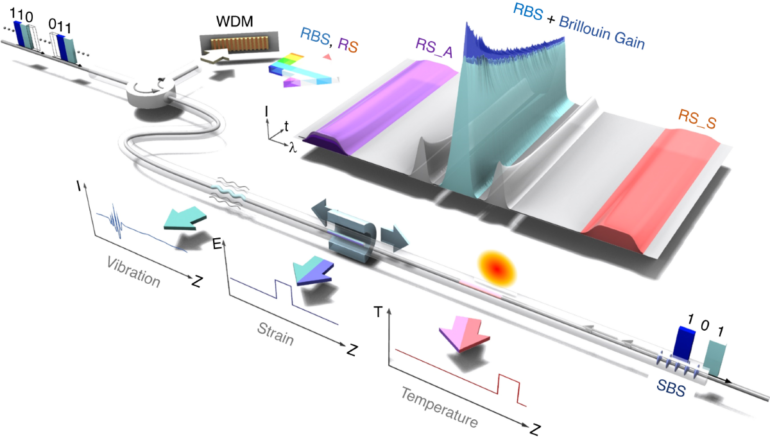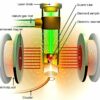Brillouin scattering is the phenomenon of the inelastic scattering of light by thermally generated acoustic vibrations. Brillouin-based optical fiber sensing can be used to measure temperature and strain distributions by determining how the light scatters in the presence of various stimuli.
This method is particularly effective when applied to correlation-domain techniques, such as Brillouin optical correlation-domain analysis and Brillouin optical correlation-domain reflectometry (BOCDR), which provide high spatial resolution and random accessibility to various measurement points. BOCDR, which utilizes spontaneous Brillouin scattering, enables single-end accessibility, making it a versatile tool for sensing applications.
In BOCDR, the spatial resolution is determined by the modulation amplitude and frequency of the light. Accurate measurement of modulation amplitude, which correlates to the peak light intensity, typically requires costly and bulky equipment like optical spectral analyzers or heterodyne detection systems. These requirements complicate the experimental setup and increase costs.
A group of researchers from Japan, led by Associate Professor Heeyoung Lee from Shibaura Institute of Technology (SIT) and including Keita Kikuchi, also from SIT, and Yosuke Mizuno from Yokohama National University, recently developed a novel method to overcome this issue. Their paper was published in the journal Scientific Reports and was made available online on 6 April 2024.
Dr. Lee says, “We have developed a new method to accurately estimate the modulation amplitude that determines spatial resolution in BOCDR without requiring additional equipment or modifications to the experimental setup.”
The researchers utilized Rayleigh scattering to estimate the modulation amplitude. Rayleigh scattering is the phenomenon in which light gets scattered when it interacts with particles that are smaller than its wavelength.
By analyzing the spectral width of noise induced by Rayleigh scattering, they could measure the modulation amplitude of the light irrespective of the length of the optical fiber, while also achieving high-frequency resolution. This innovative method, employing only the BOCDR setup with an electrical spectrum analyzer to measure Rayleigh noise components, is easy to implement, enhancing the overall convenience of the process.
Dr. Lee remarks on the long-term impact of their work, “Aging and seismic damage to civil infrastructure present significant societal challenges. Optical fiber sensing technology offers a promising solution for monitoring the structural integrity of these infrastructures.
“By embedding long optical fibers within a structure, it is possible to detect strain and temperature distributions along the fibers. Using Brillouin scattering to sense distributed strain and temperature provides highly sensitive and stable data. Our new method eliminates the need for additional devices, simplifying the process and reducing costs.”
The research team’s approach promises to advance the application of BOCDR in monitoring and ensuring the safety and reliability of critical infrastructure.
More information:
Keita Kikuchi et al, Accurate estimation of modulation amplitude in Brillouin optical correlation-domain reflectometry based on Rayleigh noise spectrum, Scientific Reports (2024). DOI: 10.1038/s41598-024-56426-2
Provided by
Shibaura Institute of Technology
Citation:
New method enhances Brillouin optical fiber sensing for infrastructure monitoring (2024, June 18)



